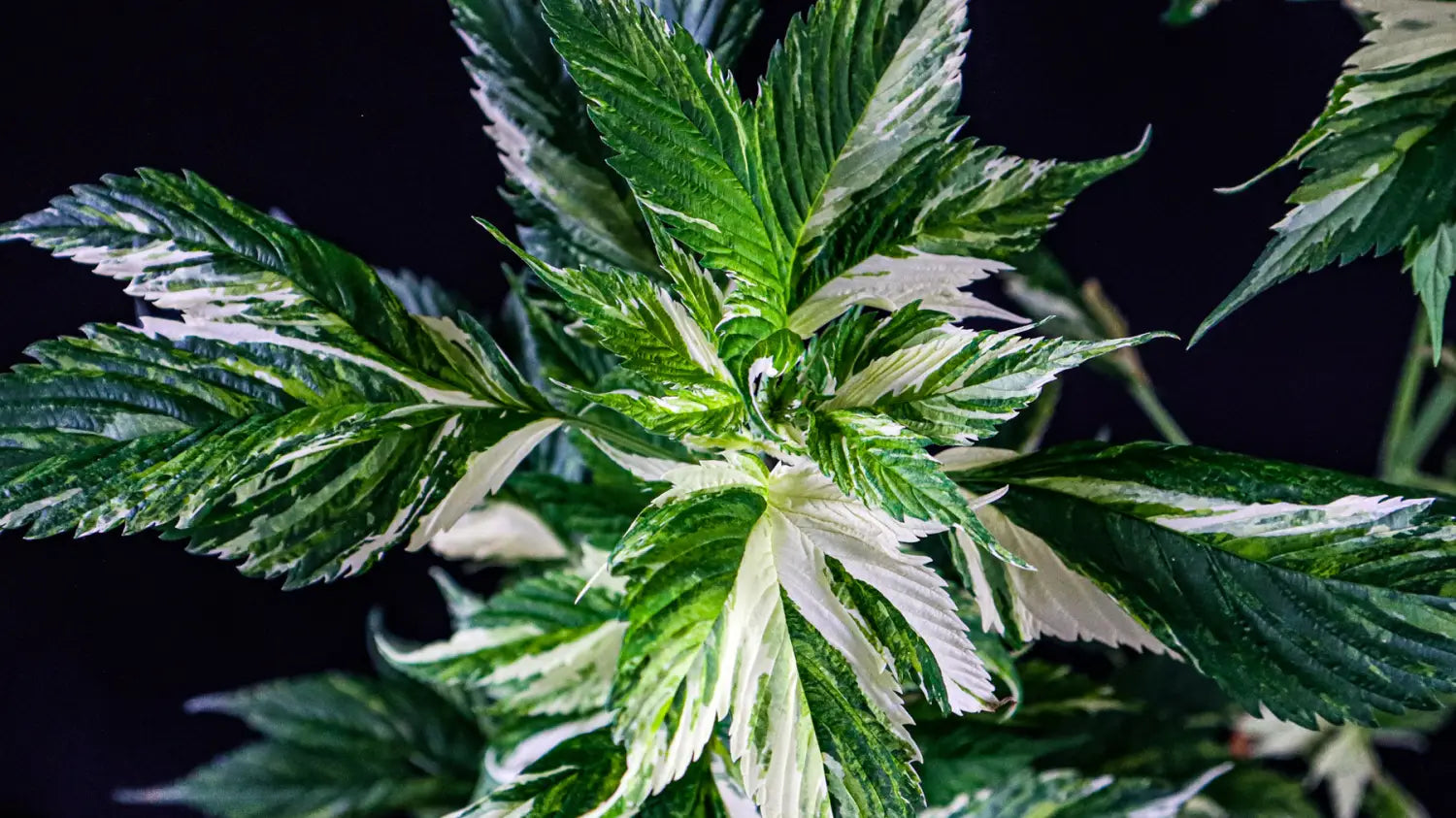Introduction of Variegated Cannabis
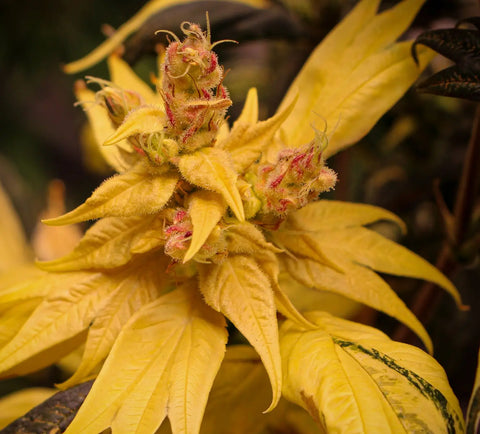
Cannabis is a versatile plant species that has been cultivated for medicinal and
recreational purposes for thousands of years. It is known for its characteristic green foliage, but some cannabis plants exhibit a rare and unique trait called variegation. Variegated cannabis plants have leaves that are patterned with different shades of green, yellow, and white. This trait is not only aesthetically pleasing but also has the potential to enhance the plant's cannabinoid and terpenoid production.
In this article, we will explore the causes of variegation, the advantages and disadvantages of cultivating variegated cannabis, and recommend some variegated cannabis varieties.
Causes for Variegation:
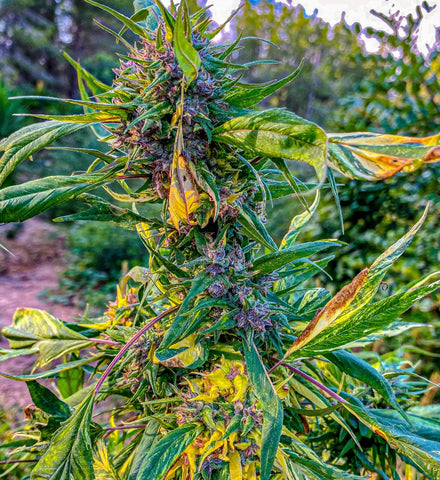
Variegation in cannabis plants can be caused by genetic mutations or environmental factors. A genetic mutation is a permanent change in the DNA sequence of a plant that can result in different physical traits, such as variegation. Research studies have shown that a specific cultivar of Cannabis sativa L. called 'Divina' has been characterized by variegated foliage as a morphological marker. It was observed that the flowers of this cultivar had high levels of cannabinoids and terpenoids. Other genetic mutations, such as albinism or crinkled growth, are also expressions of variegations. Albino cannabis plants lack chlorophyll, the pigment responsible for the green color in plants, and exhibit a white or yellowish coloration in their leaves and flowers, as displayed in the photo above of Opalo SWAG.
Environmental factors can also lead to variegation in cannabis plants. Light intensity and temperature are two factors that can affect the pigmentation of leaves. When exposed to high levels of light, some cannabis plants may develop white tips on their leaves and flowers due to photobleaching. This is when the chlorophyll is broken down by excessive light exposure, resulting in a loss of green coloration. The lack of chlorophyll in the flowers can actually improve the curing process, as chlorophyll can cause a harsh taste in the final product.
Advantages and Disadvantages
Variegated cannabis plants are not only visually striking but also have the potential to produce higher levels of cannabinoids and terpenoids. A study conducted on the ornamental cannabis cultivar 'Divina' showed that variegated plants had higher levels of cannabidiol (CBD) and terpenes compared to non-variegated plants (1). The study suggested that the loss of chlorophyll may have redirected metabolic resources towards cannabinoid and terpenoid production, resulting in higher yields.
In addition to enhanced cannabinoid and terpenoid production, variegated cannabis plants may have better resistance to pests and diseases. Some growers have reported that variegated plants are less susceptible to aphids, spider mites, and powdery mildew, although this has not been scientifically proven.
However, variegated cannabis plants also have some disadvantages. They are generally less vigorous and have a lower yield compared to non-variegated plants. This is because the loss of chlorophyll reduces the plant's ability to photosynthesize, which is crucial for growth and yield. Variegated plants also require extra care and attention, as they are more sensitive to environmental stress and require optimal growing conditions. The variegated cell tissues of the plant are generally more sensitive to heavy feeding, thus a light to medium feeding regiment is recommended. This can make them less suitable for commercial cultivation, but they are still a great option for hobby growers or for personal use.
Recommended Varieties
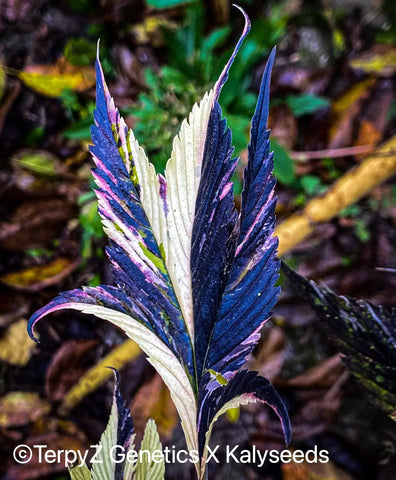
We offer a range of variegated cannabis varieties that are worth exploring. One of our popular strains is "Pablo Picasso" by Kalyseeds, which is stunningly beautiful with its white-on-green variegation, old-school Haze and Jack terpenes and high potency. Cold exposure will bring out stunning purple fades like in the photo above.
Another variegated research variety is the "Gringo var. Lemon x (GPP Mango x Lemon Grape SWAG)" by TerpyZ Research, which has yellow and green leaves and a citrusy aroma mixed with tropical fruits. This strain is a Polyhybrid mutant strain combining landrace origins and other refined mutants.
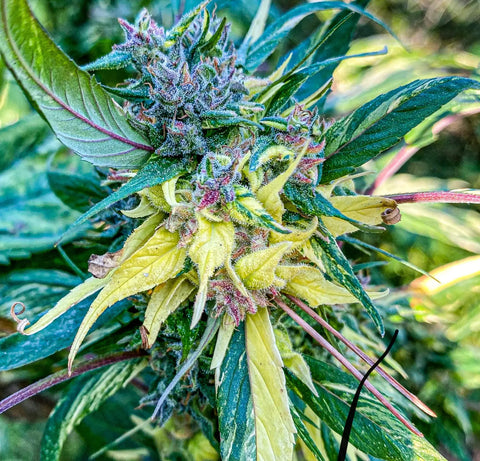
"Opalo SWAG" (photo above) is another variegated variety by Kalyseeds with a unique color pattern of green and purple leaves. This strain is known for its high resin production and outstanding exotic and fruity flavors.
Variegated cannabis plants are a novelty for true plant lovers and have a high ornamental value. The unique patterns of variegated leaves and flowers make them a desirable addition to any garden or collection. While some variegated cultivars may have slower growth rates and lower yields, they also have higher cannabinoid content and can improve the cannabis curing process. If you're interested in growing variegated cannabis, check out our variegated Cannabis collection.
References:
1) Giacomelli, R., Bedini, G., Alisi, C., & Lazzeri, L. (2020). Cannabinoids and terpenoids yields of the ornamental Cannabis sativa L. cultivar 'Divina' characterized by a variegated foliage as morphological marker. Industrial Crops and Products, 147, 112273. https://doi.org/10.1016/j.indcrop.2020.112273
2) Liu, Q., Wang, Z., & Xu, J. (2022). Diversity of Terpenoids in the Essential Oil of Cannabis sativa L. Plants with Different Morphological Characteristics. Plants, 11(18), 2383. https://doi.org/10.3390/plants11182383
3) California LightWorks. (2019, December 4). How Are White Tips Formed on Cannabis Buds? [Blog post]. Retrieved from https://californialightworks.com/blog/how-are-white-tips-formed-on-cannabis-buds/

